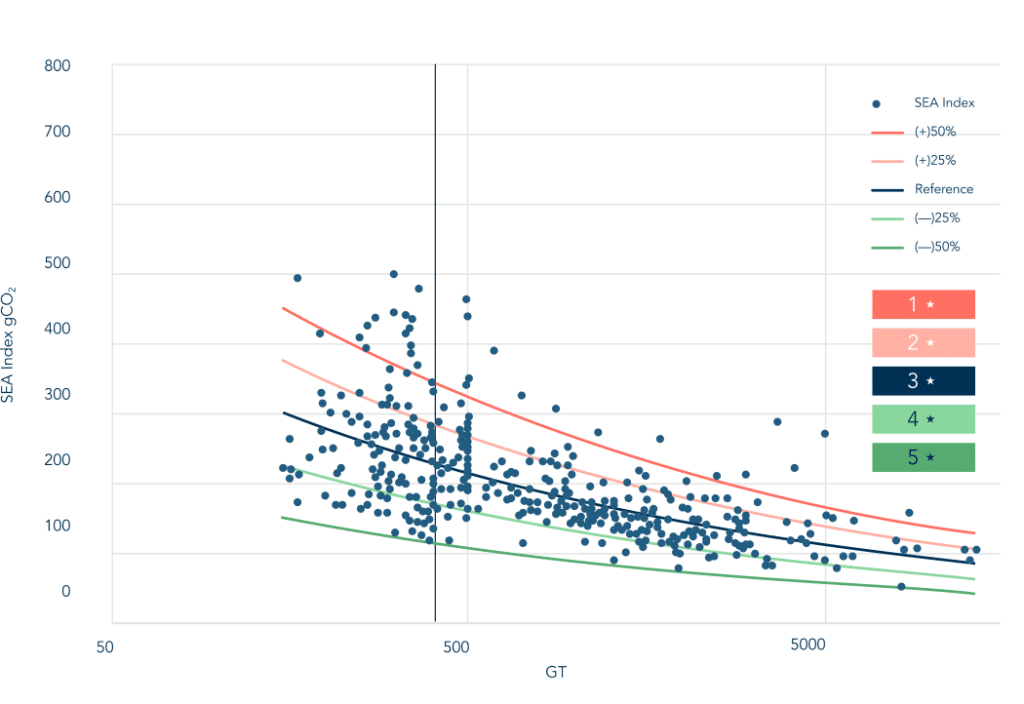- Quai Louis II, 98000 Monaco
- info@sea-index.com
SEA Index offers a suite of tools to help inform and empower yacht owners, shipbuilders, captains and the wider yachting industry. We offer trusted, unbiased methods of assessing the energy intensity of superyachts, which are grounded in globally recognised methodologies and verified by a reputable third party.
Through increased transparency, we aim to empower yacht owners with proactive measures to make informed decisions when buying, selling or chartering a vessel.


Our online tool to quickly provide an initial indication of the energy intensity of yachts over 24m, based on entered data.

The flagship SEA Index CO2 certification calculates the carbon emissions of yachts over 24m. The energy intensity of your yacht is then compared to industry benchmarks to determine its relative environmental performance, and a rating of one to five stars is given.

Developed in partnership with RINA, an operational efficiency assessment method to evaluate the lifecycle emissions of yachts, based on the choice of fuel.
The online quick tool gives yacht owners an initial rating of their vessel’s CO2 emissions, acting as a stepping stone to full certification.
Yachts can apply for full certification and become a member of the Superyacht Eco Association.
Contact us to submit your yacht's data and supporting documentation, to be independently verified by Lloyd's Register.
A SEA Index CO2 Certificate is issued by Lloyd's Register on our behalf, and can immediately be used to access exclusive benefits at ports and marinas across the Mediterranean.

Based on the IMO’s EEDI / EEXI and specifically adapted for the superyacht sector, the SEA Index methodology enables yachts over 24m to be independently assessed based on their environmental performance.
SEA Index compares a yacht’s CO2 per gross tonne emissions to establish baselines and determine its relative energy intensity. By using a nominal superyacht operating profile (at sea, anchor, quay, manoeuvring) and data from over 800 yachts, the resulting benchmark ensures every SEA Index assessment is unbiased and verifiable.
In addition, the certification now includes assessment of yachts featuring onboard innovative technology, such as Hydrogen and Methanol fuel cells.
Simply input your data into the online form, and you will receive an initial assessment of your yacht’s energy intensity within 24 hours.
The quick tool is just an initial assessment, and is only based on the numbers you enter into the online form. No supporting documentation is required.
Certification is based on the SEA Index methodology and is third-party verified by Lloyd’s Register. Supporting documentation is required to corroborate your data. Obtaining certification will result in benefits at Yacht Club de Monaco’s marina and at other ports and marinas in our network.
You can contact us via phone or email to let us know you would like to start the certification process. After an initial conversation, we will provide you with a list of all the required documentation for certification. Once we have this, it will be uploaded into the Lloyd’s Register dedicated platform.
Sometimes we will require further documentation or clarifications. We are here to guide you through the process and will keep you regularly updated on how the certification process is going.
An official certificate for presenting at our partner ports and marinas, and an improvements document, to explain how you can make your yacht more energy efficient.
Yacht’s with an energy rating of 3 stars or more will be eligible for exclusive benefits at Yacht Club de Monaco’s marina and other partner ports and marinas in our network. This can include discounts and preferential berth.
Providing all required documentation is readily available, the process takes two weeks. In the case it is not available, we will work with you to gather the documentation but the process will take longer.
No, the certification process is completely confidential. There is no direct communication between Lloyd’s Register and you as the owner or representative, and contact details are not shared.
If you receive a high rating and wish to go public, we can support in promoting your rating.
We want to ensure the ability to enjoy exploring the ocean for generations to come. By choosing a less energy intensive yacht, you will contribute to a healthier ocean to sail on.
The ocean absorbs about 30% of the CO2 that is released in the atmosphere, and as levels of atmospheric CO2 increase, acid acidification occurs. The results are devastating for marine life, especially coral reels.
Global CO2 emissions are internationally recognised as a major driver of climate change and must be addressed.
Nevertheless, in our quest to offer a comprehensive toolkit, SEA Index is currently working on ways to measure other greenhouse gases, including NOx emissions, noise and vibrations and water scarcity on yachts.
Yes, absolutely. We are proud that SEA Index has become the first-choice environmental assessment platform for stakeholders including shipyards, seeking a neutral opinion on their designs. We can provide tools and certification to help them assess their yachts, and we’re happy to support new shipyards in measuring and enhancing the energy intensity of their vessels.
Contact us today to initiate SEA Index certification of your superyacht.
SEA Index now certifies yachts with methanol & hydrogen fuel-cell technology! Contact us for more information on this new development.